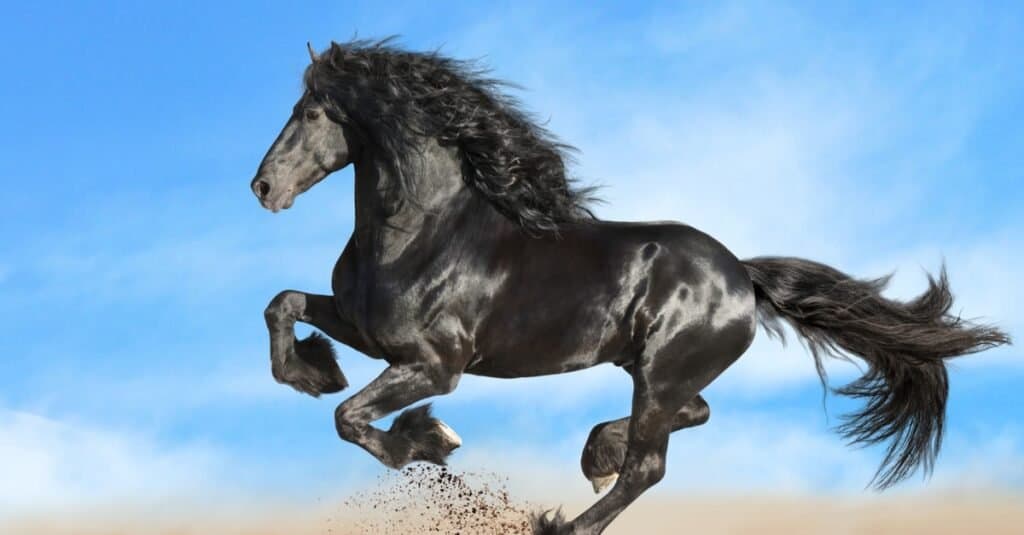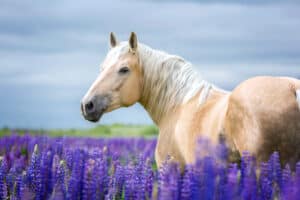Horses are an iconic symbol of the American West and played a critical role in building much of the American identity. Yet, the US has a complicated history regarding its relationship with horses, which is often misunderstood and controversial. So, are horses native to America? Here, we take a tour through the history of horses in this country.
Horses in Modern America

Horses are used for recreation and work.
©jlophoto/iStock via Getty Images
The scientific name for modern horses is Equus caballus, and there are several famous American breeds, including the Spanish Mustang and the quarter pony. No agreement exists on how many horses are found in the US today. Estimates range from 1.9 million (AVMA) to 7.2 million (AHC Foundation). Horses are used for recreational purposes, showing, and work, including rodeo, police, and military roles. What’s more, the horse population in the US can be divided into wild and domesticated horses. Wild horses are found primarily in government-designated Herd Management Areas in ten states, including Arizona, Idaho, and Wyoming. The American quarter horse is the most popular breed, and Texas has more horses than any other state. The horse industry contributes hundreds of billions of dollars each year to the US economy.
History of Modern American Horses
The immediate ancestors of wild and domesticated horses in the US can be traced back to European explorers and colonists. Horses were introduced into the country during the 15th and 16th centuries and were traded with Native Americans. In 1493, Christopher Columbus’s second voyage to the Americas brought Spanish horses. In 1519, they were introduced into what is now modern-day Mexico.
Over the years, many escaped or were released into the wild and began to breed, establishing feral herds. Therefore, it is argued that the horses you see in the US today are a non-native species.
What Is a Non-native Species?
The simple definition of a non-native species is a species that humans have introduced into an environment and is harming local ecosystems and economies. However, the reality is not so simple. It is tough to define what is and is not a native species. It could be a species that did not evolve in a particular area. However, this ignores the fact that species move around. They can grow in one location but then migrate to live in other locations. They can even adapt very well to live in their new homes.
You can also define non-native species as those that humans have introduced. Most of the non-native species causing concerns today have indeed been introduced by humans. A typical example would be the Burmese pythons that are today causing havoc in the Florida Everglades. The vast snakes are decimating native mammalian species. However, this theory also has its limitations. Other animals have been responsible for introducing non-native species in the past. For example, migrating birds have introduced seeds of non-native plants into habitats.
Were There Native American Horses?

Modern American horses descend from animals imported from Europe.
©Around the World Photos/Shutterstock.com
Yes, before the arrival of the European horses, America was home to a native species of equines. They roamed what is now the American Midwest, sharing their territories with woolly mammoths and giant sloths. Horses are a member of the Equus genus, which also contains zebras and asses. This genus was once a member of a diverse family of horses, but all the others are now extinct. It is estimated that they originated around 4 million years ago. These creatures crossed the ancient Bering land bridge into Asia, from where they spread into Europe.
Their usefulness was recognized here, and their long history with humans began. Horses were used for hunting, agriculture, war, and transportation. Humans began to selectively breed horses to suit different purposes, and many became more significant and faster.
Meanwhile, the lineage became extinct in North America around 12,000 years ago, although some experts dispute this date.
How Did American Horses Become Extinct?
The oldest known species of the Equus genus is the Equus simplicidens, also sometimes called the American zebra, which appeared around 4 million years ago. They were found from present-day Florida to Idaho. These horses later migrated to South America, Asia, Africa, and Europe.
There is no doubt that horses vanished from the American continent (probably around 10,000 to 12,000 years ago), but the reasons for this are not entirely clear. At the same time, most of North America’s large mammals also became extinct. This was around the end of the Pleistocene era, the last Ice Age.
The exact cause of this distinction is debated amongst the scientific community, and several theories exist. It may have been caused by climate change or the arrival of humans, who impacted the native habitats somehow. The extinction may be connected with the evolution of grassland vegetation. It’s even possible that an extra-terrestrial impact was responsible. This is also the leading theory for the extinction of the dinosaurs that occurred 66 million years ago.
At the time of the extinction, it is thought that bison populations were growing and spreading, and they may have been competing with the horses for food. There is evidence that the range occupied by the horses was shrinking. Also, the horses themselves were becoming smaller, possibly indicating that food was becoming scarce. There is also evidence that early humans hunted horses, which would have impacted their numbers further.
Are Horses a Native American Species?

Humans may have played a role in the extinction of the original American horses.
©Makarova Viktoria/Shutterstock.com
This is where the controversy arises. Some people argue that the horses brought to the US by the European settlers were a native species being re-introduced. Others say that the horses introduced were different from those that lived there before and were now extinct. There are complex paleontological and genetic arguments on either side. Many molecular biology studies indicate that the re-introduced horses were a species that had varied over time rather than a new species.
A further layer to this debate is the involvement of humans in the original extinction of horses in America. If humans were responsible for their demise, then their introduction, albeit thousands of years later, could be viewed as a reintroduction or re-wilding of a native species.
Does It Matter if Horses Are a Native American Species?
The prairies and plains of western America are perfect habitats for wild herds of horses. They have few predators (although mountain lions eat foals), plenty of food, and breed and spread quickly. This brings them into conflict with farmers and ranchers, who often view them as a pest. Some horses stray onto private property.
In the 1970s, federal laws protecting wild horses were passed, and feral populations have been managed since then. The main methods used are sterilization and capture. However, capture is problematic because these wild horses are difficult to adopt. Another potential option is controversial euthanasia.
There is an argument that wild horses threaten the integrity of native wildlife populations and natural habitats. This includes reduced plant species, lowered shrub cover, fewer native grasses, and more invasive plants. This impacts small reptiles and mammals who depend on this vegetation to survive. The counter-argument is that cattle are causing more damage than horses.
Summing Up: Are Horses Native to America?
Ancient horse species evolved in America, spreading to Asia and eventually into Europe. Meanwhile, the original American horses became extinct. During the 15th and 16th centuries, European settlers brought horses, and some escaped or were released and established wild breeding populations. There is currently a debate as to whether these horses are a native species or an invasive species. This has implications for the control of the wild horse population.
The photo featured at the top of this post is © LaurieSH/iStock via Getty Images
Thank you for reading! Have some feedback for us? Contact the AZ Animals editorial team.







